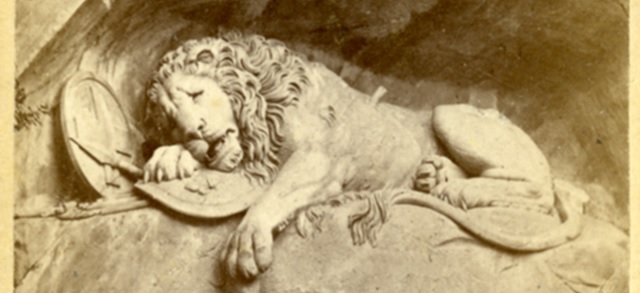
Monuments Class Projects
Architect/Sculptor of Monument
Jean-Antoine Alavoine and Joseph-Luis Duc
Preview

Identifier
28a
Medium
photograph, carte-de-viste
Keywords
Paris, France, Revolution of 1830, cartes-de-visite (card photographs), July Column:1840, Jean-Antoine Alavoine, Joseph-Luis Duc, Palace de la Bastille, neoclassical, Revolution of 1848, Louis Phillipe
Physical Dimensions
64 mm x 105 mm
Date of Publication
2022
Date of Publication
Unkown
Name of Monument
July Column (Colonne de Juillet)
Date of Creation of Monument
Summer 7-1831
Date of Completion or Dedication of Monument
Summer 7-1840
City of Monument
Paris
Location within City
Place de la Bastille
State/Province of Monument
Île-de-France
Country of Monument
France
Description
A carte-de-visite of the July Column (or Colonne de Juillet), a large Corinthian-style column that was built on the site of the Bastille prison to commemorate the 1830 Revolution. While a monument was originally planned to be built in 1793 to commemorate the Fall of the Bastille and the beginning of the 1789 French Revolution, nothing was built until King Louis-Phillipe commissioned this column which was finished in 1840. Designed by Jean Antoine Alavoine and Joseph Luis Duc, the column stands at 169 feet and is topped with an angel called the Spirit of Freedom. The vaults underneath contain the remains of rioters killed in both the Revolution of 1830, which brought King Louis-Phillipe to power, and the 1848 Revolution that overthrew him.
School of Art/Architecture
Neoclassical
Publisher
Teruel
Digital Date
Spring 1-19-2022
Copyright
Original physical carte-de-visite is in the public domain. Digital copy scanned by Rod Library, ©2022 Rod Library, University of Northern Iowa.
Rights Advisory
Original print carte-de-visite card is in the public domain; U.S. and International copyright laws protect this digital object. Commercial use of this digital object is not permitted without prior permission of the copyright holder.
Creative Commons License

This work is licensed under a Creative Commons Attribution-NonCommercial 4.0 International License
File Format
image/jpeg



Comments
The July Column, known as the Colonne de Juillet in French, is a neoclassical Corinthian-Style Column located in Paris in the Place de la Bastille. Standing at about 154 feet or 47 meters, the column is made of bronze, with a stone pedestal. There is a statue of an angel on top, called the “Génie de la Liberté,” or the Spirit of Liberty in English, sculpted by Agustin Dumont (1). Underneath the column, four vaults hold the bodies of individuals who died in both the Revolution of 1830 and the Revolution of 1848.
A neoclassical monument, the column is based on Roman honorific columns, which the ancient Romans erected to commemorate emperors, leaders, or battles, such as Trajan’s Column in Rome (2). The complex Corinthian style of the July Column with its lavish decorations and the statue on top are neoclassical hallmarks. This monument fully embraces the legacy of the Roman columns in honoring the revolutionaries of 1830.
The monument's location, the Place de la Bastille, was initially planned to be the site of a memorial commemorating the fall of the Bastille, an armory location and small prison, on July 14, 1789, at the beginning of the French Revolution. This monument never came to fruition, although it was a potential location for one of the many monuments planned by Napolean during his reign (3). In 1830 King Louis-Phillipe commissioned the monument to commemorate those who died in the French Revolution of 1830, the Revolution that put him into power by overthrowing the restored Bourbon monarchy.
Jean-Antoine Alavoine designed the statue, but the construction was overseen by his partner Joseph-Louis Duc (4). Construction of the monument began in July 1835 and finished by July 1840. During its dedication, Hector Berlioz, a French Romantic composer, conducted the symphonic piece he wrote for the ceremony: “Grande symphonie funèbre et triomphale.” The music accompanied the internment of the revolutionaries' bodies (5).
While the 1840 monument stood to honor the revolutionaries who brought King Louis-Phillipe to power, his reign only lasted eight more years. He was overthrown in the Revolution of 1848, bringing in the reign of Napoleon the III and creating a short-lived second French Republic. There 1848 revolutionaries burned his throne at the foot of the July Column. Following 1848 Revolution, the bodies of 1848 revolutionaries joined the bodies of 1830 in the vault’s under the column (6).
References
Centre Des Monuments Nationaux. n.d. “History of the Monument.” Colonne de Juillet, place de la Bastille. Accessed March 10th, 2022. http://www.colonne-de-juillet.fr/en/.
“Colonne de Juillet, Paris | 232992.” n.d. EMPORIS. Accessed March 10th, 2022. https://www.emporis.com/buildings/232992/colonne-de-juillet-paris-france.
Craven, Jackie. “The History of Corinthian Columns,” Thoughtco, January 20th, 2019. https://www.thoughtco.com/what-is-a-corinthian-column-177504
Limbird, J. 1841. “The July Column (At Paris).” The Mirror 37:161-162. https://babel.hathitrust.org/cgi/pt?id=nyp.33433081738449&view=1up&seq=184&skin=2021.
Hendrix, David. 2016. “Roman Honorific Monuments.”. The Byzantine Legacy. Accessed April 20th, 2022. https://www.thebyzantinelegacy.com/roman-monuments
Ministere de la Culture. N.d. “July Column, Place de la Bastille.” Accessed April 20th, 2022. https://www.culture.gouv.fr/en/Espace-documentation/Repertoire-des-ressources-documentaire Monuments-nationaux/Colonne-de-Juillet-Place-de-la-Bastille
Timbs, John, C. W. Vincent, and James Mason. 1841. “The Casting of the July Column.” Year Book of Facts in Science and Art 43:67-68. https://babel.hathitrust.org/cgi/pt?id=umn.31951d00122702u&view=1up&seq=75&skin=2021.
Un Jour de Plus a Paris. N.d. “The July Column of Place de La Bastille”. Accessed April 20th, 2022. https://www.unjourdeplusaparis.com/en/paris-insolite/colonne-de-juillet-bastille
1. Timbs, John, C. W. Vincent, and James Mason. 1841. “The Casting of the July Column.” Year Book of Facts in Science and Art 43:67-68.
2. Hendrix, David. 2016. “Roman Honorific Monuments.”
3. Un Jour de Plus a Paris. N.d. “The July Column of Place de La Bastille”
4. Limbird, J. 1841. “The July Column (At Paris).” The Mirror 37:161-162.
5. Ministere de la Culture. N.d. “July Column, Place de la Bastille.”
6. Centre Des Monuments Nationaux. n.d. “History of the Monument.”